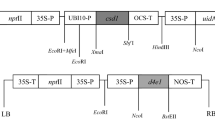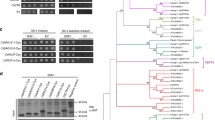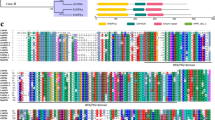Abstract
Key message
Expression of synthesized cecropin B genes in the citrus phloem, where Candidatus Liberibacter asiaticus resides, significantly decreased host susceptibility to Huanglongbing.
Abstract
Huanglongbing (HLB), associated with Candidatus Liberibacter asiaticus bacteria, is the most destructive disease of citrus worldwide. All of the commercial sweet orange cultivars lack resistance to this disease. The cationic lytic peptide cecropin B, isolated from the Chinese tasar moth (Antheraea pernyi), has been shown to effectively eliminate bacteria. In this study, we demonstrated that transgenic citrus (Citrus sinensis Osbeck) expressing the cecropin B gene specifically in the phloem had a decreased susceptibility to HLB. Three plant codon-optimized synthetic cecropin B genes, which were designed to secrete the cecropin B peptide into three specific sites, the extracellular space, the cytoplasm, and the endoplasmic reticulum, were constructed. Under the control of the selected phloem-specific promoter GRP1.8, these constructs were transferred into the citrus genome. All of the cecropin B genes were efficiently expressed in the phloem of transgenic plants. Over more than a year of evaluation, the transgenic lines exhibited reduced disease severity. Bacterial populations in transgenic lines were significantly lower than in the controls. Two lines, in which bacterial populations were significantly lower than in others, showed no visible symptoms. Thus, we demonstrated the potential application of the phloem-specific expression of an antimicrobial peptide gene to protect citrus plants from HLB.





Similar content being viewed by others
References
Albrecht U, Bowman KD (2012) Transcriptional response of susceptible and tolerant citrus to infection with Candidatus Liberibacter asiaticus. Plant Sci 185:118–130. doi:10.1016/j.plantsci.2011.09.008
Alfano JR, Collmer A (1996) Bacterial pathogens in plants: life up against the wall. Plant Cell 8:10. doi:10.1105/tpc.8.10.1683
Aritua V, Achor D, Gmitter FG, Albrigo G, Wang N (2013) Transcriptional and microscopic analyses of citrus stem and root responses to Candidatus Liberibacter asiaticus infection. PloS one 8:e73742. doi:10.1371/journal.pone.0073742
Band VI, Weiss DS (2015) Mechanisms of antimicrobial peptide resistance in gram-negative bacteria. Antibiotics 4:18–41. doi:10.3390/antibiotics4010018
Bent AF, Mackey D (2007) Elicitors, effectors, and R genes: the new paradigm and a lifetime supply of questions. Annu Rev Phytopathol 45:399–436. doi:10.1146/annurev.phyto.45.062806.094427
Bertaccini A, Duduk B (2010) Phytoplasma and phytoplasma diseases: a review of recent research. Phytopathol Mediterr 48:355–378. doi:10.1146/annurev.micro.54.1.221
Boscariol RL et al (2006) Attacin A gene from Tricloplusia ni reduces susceptibility to Xanthomonas axonopodis pv. citri in transgenic Citrus sinensis ‘Hamlin’. J Am Soc Hortic Sci 131:530–536
Bové JM (2006) Huanglongbing: a destructive, newly-emerging, century-old disease of citrus. J Plant Pathol 88:7–37. doi:10.1371/journal.pone.0111032
Bové JM (2014) Huanglongbing or yellow shoot, a disease of Gondwanan origin: will it destroy citrus worldwide? Phytoparasitica 42:579–583. doi:10.1007/s12600-014-0415-4
Chen HM, Wang W, Smith D, Chan SC (1997) Effects of the anti-bacterial peptide cecropin B and its analogs, cecropins B-1 and B-2, on liposomes, bacteria, and cancer cells. Bba Gen Subj 1336:171–179. doi:10.1016/S0304-4165(97)00024-X
Coca M, Penas G, Gomez J, Campo S, Bortolotti C, Messeguer J, Segundo BS (2006) Enhanced resistance to the rice blast fungus Magnaporthe grisea conferred by expression of a cecropin A gene in transgenic rice. Planta 223:392–406. doi:10.1007/s00425-005-0069-z
Company N et al (2014) The production of recombinant cationic α-helical antimicrobial peptides in plant cells induces the formation of protein bodies derived from the endoplasmic reticulum. Plant Biotechnol J 12:81–92. doi:10.1111/pbi.12119
Cornelissen BJ, Horowitz J, van Kan JA, Goldberg RB, Bol JF (1987) Structure of tobacco genes encoding pathogenesis-related proteins from the PR-1 group. Nucleic Acids Res 15:6799–6811. doi:10.1093/nar/15.17.6799
Cui L et al (2008) Histone acetyltransferase inhibitor anacardic acid causes changes in global gene expression during in vitro Plasmodium falciparum development. Eukaryot Cell 7:1200–1210. doi:10.1128/EC.00063-08
da Graca JV, Douhan GW, Halbert SE, Keremane ML, Lee RF, Vidalakis G, Zhao H (2016) Huanglongbing: an overview of a complex pathosystem ravaging the world’s citrus. J Integr Plant Biol 58:373–387. doi:10.1111/jipb.12437
Datla RS, Hammerlindl JK, Pelcher LE, Crosby WL, Selvaraj G (1991) A bifunctional fusion between beta-glucuronidase and neomycin phosphotransferase: a broad-spectrum marker enzyme for plants. Gene 101:239–246
Donmez D, Simsek O, Izgu T, Kacar YA, Mendi YY (2013) Genetic Transformation in citrus. The Scientific World J 2013:1–8. doi:10.1155/2013/491207
Duan Y et al (2009) Complete genome sequence of citrus huanglongbing bacterium, ‘Candidatus Liberibacter asiaticus’ obtained through metagenomics. Mol Plant Microbe Interact 22:1011–1020. doi:10.1094/MPMI-22-8-1011
Dutt M, Ananthakrishnan G, Jaromin MK, Brlansky RH, Grosser JW (2012) Evaluation of four phloem-specific promoters in vegetative tissues of transgenic citrus plants. Tree Physiol 32:83–93. doi:10.1093/treephys/tpr130
Dutt M, Barthe G, Irey M, Grosser J (2015) Transgenic citrus expressing an Arabidopsis NPR1 Gene exhibit enhanced resistance against Huanglongbing (HLB; citrus greening). PloS one 10:e0137134. doi:10.1371/journal.pone.0137134
Florack D, Allefs S, Bollen R, Bosch D, Visser B, Stiekema W (1995) Expression of giant silkmoth cecropin B genes in tobacco. Transgenic Res 4:132–141. doi:10.1007/BF01969415
Fu SM, Hartung J, Zhou CY, Su HN, Tan J, Li ZA (2014) Ultrastructural changes and putative phage particles observed in sweet orange leaves infected with ‘Candidatus Liberibacter asiaticus’. Plant Dis 99:320–324. doi:10.1094/PDIS-01-14-0106-RE
Gong X, Liu J (2013) Genetic transformation and genes for resistance to abiotic and biotic stresses in Citrus and its related genera. Plant Cell Tissue Org Cult 113(2):137–147. doi:10.1007/s11240-012-0267-x
Gurr SJ, Rushton PJ (2005a) Engineering plants with increased disease resistance: how are we going to express it? Trends Biotechnol 23:283–290. doi:10.1016/j.tibtech.2005.04.009
Gurr SJ, Rushton PJ (2005b) Engineering plants with increased disease resistance: what are we going to express? Trends Biotechnol 23:275–282. doi:10.1016/j.tibtech.2005.04.007
Shokrollah H, Abdullah TL, Sijam K, Abdullah NK, Abdullah AP (2009) Differential reaction of citrus species in Malaysia to huanglongbing (HLB) disease using grafting method. Am J Agric Bio Sci 4:32–38
He Y, Chen S, Peng A, Zou X, Xu L, Lei T (2011) Production and evaluation of transgenic sweet orange (Citrus sinensis Osbeck) containing bivalent antibacterial peptide genes (Shiva A and Cecropin B) via a novel Agrobacterium-mediated transformation of mature axillary buds. Sci Hortic 128:99–107. doi:10.1016/j.scienta.2011.01.002
Hightower R, Baden C, Penzes E, Dunsmuir P (1994) The expression of cecropin peptide in transgenic tobacco does not confer resistance to Pseudomonas syringae pv tabaci. Plant Cell Rep 13:295–299. doi:10.1007/BF00233324
Hilf ME, Sims KR, Folimonova SY, Achor DS (2013) Visualization of ‘Candidatus Liberibacter asiaticus’ cells in the vascular bundle of citrus seed coats with fluorescence in situ hybridization and transmission electron microscopy. Phytopathology 103:545–554. doi:10.1094/PHYTO-09-12-0226-R
Holásková E, Galuszka P, Frébort I, Öz MT (2015) Antimicrobial peptide production and plant-based expression systems for medical and agricultural biotechnology. Biotechnol Adv 33:1005–1023. doi:10.1016/j.biotechadv.2015.03.007
Hou ZX, Huang WD (2005) Immunohistochemical localization of IAA and ABP1 in strawberry shoot apexes during floral induction. Planta 222:678–687. doi:10.1007/s00425-005-0014-1
Jan PS, Huang HY, Chen HM (2010) Expression of a synthesized gene encoding cationic peptide cecropin B in transgenic tomato plants protects against bacterial diseases. Appl Environ Microbiol 76:769–775. doi:10.1128/AEM.00698-09
Jaynes JM, Nagpala P, Destefanobeltran L, Huang JH, Kim JH, Denny T, Cetiner S (1993) Expression of a cecropin-B lytic peptide analog in transgenic tobacco confers enhanced resistance to bacterial wilt caused by Pseudomonas Solanacearum. Plant Sci 89:43–53. doi:Doi:10.1016/0168-9452(93)90169-Z
Jefferson RA, Kavanagh TA, Bevan MW (1987) GUS fusions: beta-glucuronidase as a sensitive and versatile gene fusion marker in higher plants. EMBO J 6:3901–3907
Johnson EG, Wu J, Bright DB, Graham JH (2014) Association of ‘Candidatus Liberibacter asiaticus’ root infection, but not phloem plugging with root loss on huanglongbing-affected trees prior to appearance of foliar symptoms. Plant Pathol 63:290–298. doi:10.1111/ppa.12109
Lutcke HA, Chow KC, Mickel FS, Moss KA, Kern HF, Scheele GA (1987) Selection of AUG initiation codons differs in plants and animals. EMBO J 6:43–48
Melo MN, Ferre R, Castanho MA (2009) Antimicrobial peptides: linking partition, activity and high membrane-bound concentrations. Nat Rev Microbiol 7:245–250. doi:10.1038/nrmicro2095
Mills D, Hammerschlag FA (1993) Effect of cecropin-B on peach pathogens, protoplasts, and cells. Plant Sci 93:143–150. doi:Doi:10.1016/0168-9452(93)90043-Y
Mills D, Hammerschlag FA, Nordeen RO, Owens LD (1994) Evidence for the breakdown of cecropin B by proteinases in the intercellular fluid of peach leaves. Plant Sci 104:17–22. doi:10.1016/0168-9452(94)90186-4
Miyata LY, Harakava R, Stipp LC, Mendes BM, Appezzato-da-Gloria B, de Assis Alves Mourao Filho F (2012) GUS expression in sweet oranges (Citrus sinensis L. Osbeck) driven by three different phloem-specific promoters. Plant Cell Rep 31:2005–2013. doi:10.1007/s00299-012-1312-2
Murashige T, Skoog F (1962) A revised medium for rapid growth and bio assays with tobacco tissue cultures. Physiol Plant 15:473–497
Nadal A et al (2012) Constitutive expression of transgenes encoding derivatives of the synthetic antimicrobial peptide BP100: impact on rice host plant fitness. BMC Plant Biol 12:159–181. doi:10.1186/1471-2229-12-159
Nawrocki KL, Crispell EK, McBride SM (2014) Antimicrobial peptide resistance mechanisms of Gram-positive bacteria. Antibiotics 3:461–492. doi:10.3390/antibiotics3040461
Salas CE, Badillo-Corona JA, Ramirez-Sotelo G, Oliver-Salvador C (2015) Biologically active and antimicrobial peptides from plants. Biomed Res Int 2015:102–129. doi:10.1155/2015/102129
Sharma A, Sharma R, Imamura M, Yamakawa M, Machii H (2000) Transgenic expression of cecropin B, an antibacterial peptide from Bombyx mori, confers enhanced resistance to bacterial leaf blight in rice. FEBS Lett 484:7–11. doi:10.1016/S0014-5793(00)02106-2
Shaw JE, Alattia JR, Verity JE, Prive GG, Yip CM (2006) Mechanisms of antimicrobial peptide action: studies of indolicidin assembly at model membrane interfaces by in situ atomic force microscopy. J Struct Biol 154:42–58. doi:10.1016/j.jsb.2005.11.016
Sjolund RD (1997) The phloem sieve element: a river runs through It. Plant Cell 9:1137–1146. doi:10.1105/tpc.9.7.1137
Straus SK, Hancock RE (2006) Mode of action of the new antibiotic for Gram-positive pathogens daptomycin: comparison with cationic antimicrobial peptides and lipopeptides. Biochim Biophys Acta 1758:1215–1223. doi:10.1016/j.bbamem.2006.02.009
Tatineni S, Sagaram US, Gowda S, Robertson CJ, Dawson WO, Iwanami T, Wang N (2008) In planta distribution of ‘Candidatus Liberibacter asiaticus’ as revealed by polymerase chain reaction (PCR) and real-time PCR. Phytopathology 98:592–599. doi:10.1094/PHYTO-98-5-0592
Trivedi P et al (2009) Quantification of viable Candidatus Liberibacter asiaticus in hosts using quantitative PCR with the aid of ethidium monoazide (EMA). Eur J Plant Pathol 124:553–563. doi:10.1007/s10658-009-9439-x
Vervliet G, Holsters M, Teuchy H, Van Montagu M, Schell J (1975) Characterization of different Plaque-forming and defective temperate phages in agrobacterium strains. J Gen Virol 26(1):33–48
Wang N, Trivedi P (2013) Citrus huanglongbing: a newly relevant disease presents unprecedented challenges. Phytopathology 103:652–665. doi:10.1094/PHYTO-12-12-0331-RVW
Weise A, Barker L, Kuhn C, Lalonde S, Buschmann H, Frommer WB, Ward JM (2000) A new subfamily of sucrose transporters, SUT4, with low affinity/high capacity localized in enucleate sieve elements of plants. Plant Cell 12:1345–1355 doi:10.1105/tpc.12.8.1345
Xoconostle-Cázares B et al (1999) Plant paralog to viral movement protein that potentiates transport of mRNA into the phloem. Science 283:94–98. doi:10.1126/science.283.5398.94
Zhang Q, Zhang J, Huang Z, Tan S, Guo Z (1995) The bactericidal effect of antibacterial peptide from Chinese Oak silkworm on the pathogen of bacterial ulcer and yellow shoot disease in citrus. Acta Sericol Sin 21:77–81
Zhang S et al (2011) ‘Ca. Liberibacter asiaticus’ carries an excision plasmid prophage and a chromosomally integrated prophage that becomes lytic in plant infections. Mol Plant Microbe Interact 24:458–468. doi:10.1094/MPMI-11-10-0256
Zou X, Li D, Luo X, Luo K, Pei Y (2008) An improved procedure for Agrobacterium-mediated transformation of trifoliate orange (Poncirus trifoliata L. Raf.) via indirect organogenesis. In Vitro Cell Dev Biol Plant 44:169–177. doi:10.1007/s11627-008-9106-5
Zou X et al (2014a) Secreted expression of cecropin B gene enhances resistance to Xanthomonas axonopodis pv. citri in transgenic citrus sinensis‘Tarocco rsquo. Acta Hortic Sin 41:417–428
Zou X et al (2014b) Activation of three pathogen-inducible promoters in transgenic citrus (Citrus sinensis Osbeck) after Xanthomonas axonopodis pv. citri infection and wounding. Plant Cell Tissue Org Cult 117:85–98. doi:10.1007/s11240-013-0423-y
Acknowledgements
This work was supported by grants from the National Natural Sciences Foundation of China (31272150, to XZ), the Earmarked Fund for China Agriculture Research System (CARS-27, to SC), and the Fundamental Research Funds for the Central Universities (XDJK2012B023, to XZ).
Author contributions
XZ designed the experiments, constructed the vectors, and wrote the manuscript. LX and AP performed the citrus genetic transformations. XJ evaluated the resistance to HLB. TL and YH performed molecular analyses. LY performed the Southern blot analysis. SC analyzed the data. All of the authors read and approved the manuscript.
Author information
Authors and Affiliations
Corresponding authors
Ethics declarations
Conflict of interest
The authors declare that they have no conflicts of interest.
Electronic supplementary material
Below is the link to the electronic supplementary material.
Rights and permissions
About this article
Cite this article
Zou, X., Jiang, X., Xu, L. et al. Transgenic citrus expressing synthesized cecropin B genes in the phloem exhibits decreased susceptibility to Huanglongbing. Plant Mol Biol 93, 341–353 (2017). https://doi.org/10.1007/s11103-016-0565-5
Received:
Accepted:
Published:
Issue Date:
DOI: https://doi.org/10.1007/s11103-016-0565-5




